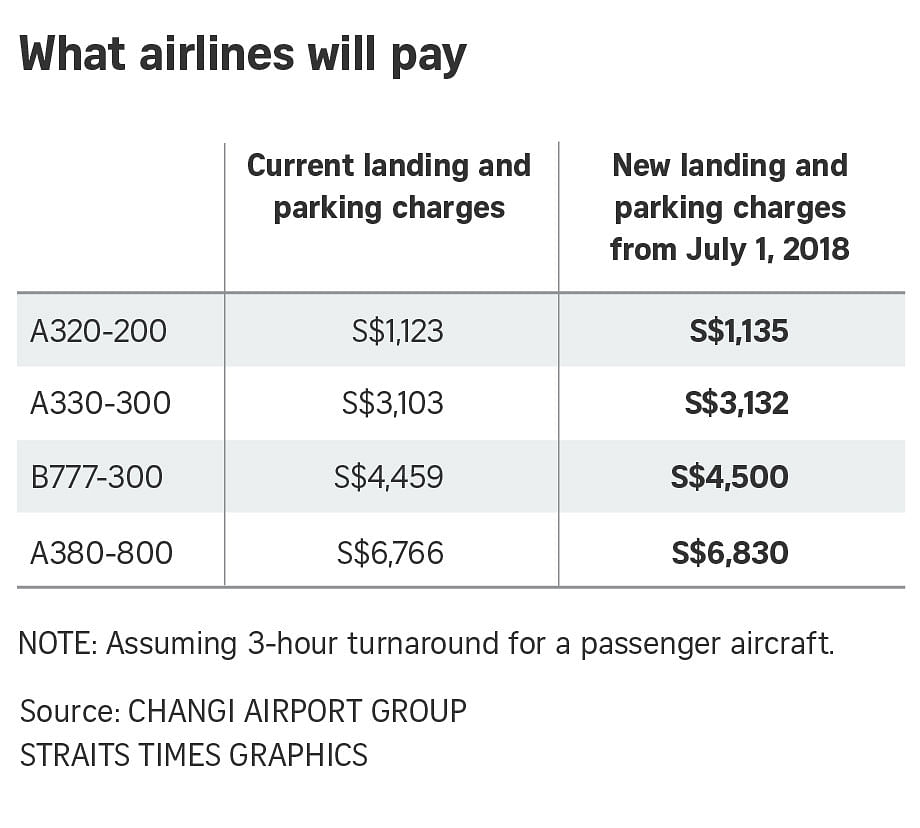Travellers using Changi Airport to pay higher fees and charges from July 1
Sign up now: Get ST's newsletters delivered to your inbox
Karamjit Kaur
Follow topic:
SINGAPORE - Passengers who now pay $34 to fly out of Changi will have to fork out an extra $13.30 from July 1, to help fund major expansion plans for the airport that aim to cement Singapore's status as a key aviation hub.
Transit passengers will have to pay $3 more for each flight, with the increases to be included in their air fares.
Airlines will also have to pay more in aircraft parking and landing fees, said the Ministry of Transport, Civil Aviation Authority of Singapore (CAAS) and Changi Airport Group on Wednesday (Feb 28).
By April 1, 2024, the total departure fee for passengers departing from Changi Airport will go up to $62.30, the authorities said, even as they stressed that the bulk of the costs for the Changi East development, which includes the construction of Terminal 5, will be borne by the Government and Changi Airport Group (CAG), which operates the airport.
It is not clear if the departure fee will be reduced when the Changi East development is completed and T5 opened around 2030.
The departure fee is made up of a passenger service and security fee, an aviation levy charge and the new airport development levy.
The Sunday Times had reported in January that passenger fees will increase by between $10 and $15 to help pay for the works, which include a third runway, ground improvement works at the site of more than 1,000ha and the building of massive drains and tunnels, some of which will move bags and people between T5 and the current airport.
The total bill is expected to run into tens of billions, the Government said on Wednesday, without divulging actual numbers.

When completed, T5 is expected to eventually handle up to 70 million passengers a year - more than T1, T2 and T3 combined. However, the third runway being built in the same project will be operational in the early 2020s before the completion of T5.
CAAS director-general Kevin Shum told journalists: "Changi East is our investment to secure Singapore's future. We need to cater to increasing air traffic as Singaporeans travel more. At the same time, we want to plug into the growth of the region. That is why we are doing all of these to ensure that Singapore remains the premier air hub for the region."
Transport Minister Khaw Boon Wan stressed in a Facebook posting that the Government will be the main funder through grants, while CAAS and CAG will dip into their reserves and future surpluses to help fund T5.
"Airport users, like airlines and passengers will also have to do their part in funding this project... Having the Government and the airport community contribute towards the project is a fair way to finance the project, which will bring benefits to our people, businesses and the Singapore economy."
CAG said in a statement that the airport handled a record number of 62.2 million passengers in 2017, with growth expected to continue with the demand for air travel in the Asia-Pacific region projected to triple over the next two decades.
Based on its projections, the airport's current handling capacity of 85 million passengers per annum is expected to be fully utilised by the late 2020s.
"Without further expansion, service standards may drop, with passengers experiencing delays," the airport said.

Other airports have introduced user charges to support growth plans.
In 2016, Hong Kong International Airport, which is building a third runway due to be completed in 2024, started collecting between HK$70 and HK$180 (S$11.85 to S$30.50) a traveller. Also in 2016, airports in Dubai, United Arab Emirates and Doha in Qatar introduced a departure tax for travellers - the equivalent of about $13 - to help fund ongoing expansion projects.
The International Air Transport Association - the global voice of airlines - has, however, said repeatedly it does not support pre-funding, where airlines have to pay for services and facilities they do not currently utilise.
Its regional vice-president (Asia Pacific) Conrad Clifford told The Straits Times: "While we recognise that the (Singapore) Government will be bearing the majority of the costs for the development of Changi East and Terminal 5, we are still disappointed with the decision to proceed with the pre-funding model despite the feedback provided by the industry.
"We are also hoping to have greater transparency on what is the projected cost of Changi East and Terminal 5, and how the costs are being apportioned between the Government, CAG, airlines and passengers."
He noted that aviation is an economic catalyst and the added capacity does not just benefit the aviation community but the entire Singapore economy, including tourism, trade and manufacturing.
He said: "Making air travel more expensive for passengers will have a negative impact on travel, tourism, and as a result, aviation's contribution to an economy. Increasing charges for airlines could also affect the financial viability of their services to and from the airport."

